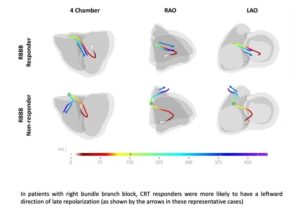Improving CRT response in heart failure patients is another CineECG feature.
Next to the HRS 2023 presentation regarding the added value of CineECG in identifying the origin of atrial ectopic activity (see our previous blog) last week’s conference in New Orleans also became a platform for presenting another clinical added value option of CineECG.
In this blog we focus on the results of Tanmay Gokhale, Salah Al-zaiti and Samir F. Saba, all working at the University of Pittsburg Medical Center (UPMC).
Their study focuses on improving the selection of CRT patients. Cardiac Resynchronization therapy (CRT) is a cornerstone of treatment for advanced heart failure, but not all patients derive equal benefit from this intervention. CRT non-response percentages are between 30%-40% and have been for the past 20 years. Within the known reasons for CRT non-response patient selection is one of the key aspects. Current approaches of using electrocardio-graphic and echocardiographic parameters to identify likely CRT responders have not shown breakout solutions for this unmet need to predict, before CRT implant, if a person will benefit from CRT.

The UPMC team applied CIneECG in their analysis of retrospective pre-CRT placement ECGs and investigated if the relationship between ECG and heart anatomy offers more insights to qualify heart failure patients for CRT and this way find a solution for reducing the number of CRT non-response.
In their conclusion the UPMC team has identified three (Cine)ECG features which were independently predictive of CRT response: left bundle branch block (LBBB); leftward direction of late repolarization potentials and location of center-of-mass of terminal cardiac activation.
The existence of a left bundle branch block was already known as a CRT effectiveness predictive feature. But the other features appear to be especially relevant in patients with a right bundle branch block according to the UPMC team. And CineECG supports easy identification of all 3 features which is good news for our team.
We are grateful for the work executed in Pittsburg and the researchers focus on improving CRT response and we look forward to prolong our collaboration to increase the quality and ease of using 12 lead ECG interpretation. Because there’s more to see in the ECG!
If you want to learn more go to : https://eppro01.ativ.me/src/EventPilot/php/express/web/planner.php?id=HRS23
and search for CineECG or click here






